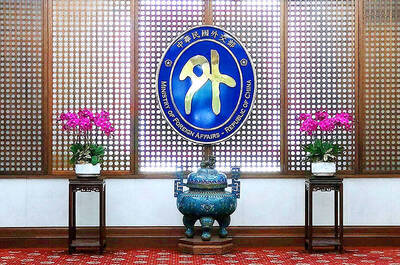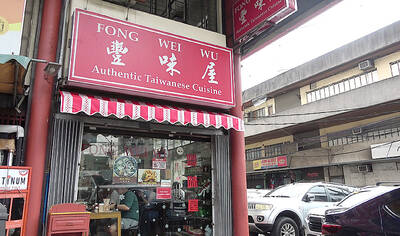The Council of Agriculture (COA) yesterday said that a report on whether a Kaohsiung County chicken farm had been affected by bird flu would be out in the next two days.
Responding to speculation that the examination process may have been delayed as the possible infection was reported almost two months ago, COA Bureau of Animal and Plant Health Inspection and Quarantine Deputy Director-General Huang Kuo-ching (黃國青) said the examination process followed protocol.
Secondary results will be published this week, Huang said.

PHOTO: GEORGE TSORNG, TAIPEI TIMES
“On Oct. 21 we received a report about a possible H5N2 infection at a chicken farm in Kaohsiung County and went to collect samples for analysis; [we] had the results by Nov. 12,” Huang said.
Though the results were positive, because the death rate of the birds was less than 3 percent and the chickens did not have respiratory tract infections, the results were inconsistent with the health condition of the affected chicken population, Huang said, adding: “The expert panel decided to collect a second sample on the same day [Nov. 12th] … the result of which will be available in the next two days.”
All remaining 18,000 chickens at the farm were culled as a precautionary measure, the COA said.
The former chairman of the inter-ministy avian and pandemic influenza control committee, Chen Chien-jen (陳建仁), of the Academia Sinica, said that whether Taiwan has a bird flu epidemic or not, the COA should make comprehensive epidemic-prevention efforts upon the discovery of any strain of bird flu.
He added that the COA should make the information available to minimize public concern.
Chen said that while the polymerase chain reaction (PCR) technique can reveal whether an examination sample carries the H5N2 virus strain within a day, the separation and cultivation of the virus, which can further confirm PCR results, takes a month.
What is important is that, “[In the meantime], a standard operating procedure [SOP] should be launched to prevent the possible spread of an epidemic [before results are out],” he said.
Chen said that a complete disinfection should be carried out at the affected chicken farm, and the chickens should be inspected and possibly slaughtered as soon as a possible epidemic is suspected.
H5N2 is a weak strain of the bird flu virus that is unlikely to be transmitted to humans and the law does not require that the discovery of the virus be reported.
However, as the news is now out in the open, Chen said, “If the government had done [all it could to prevent an epidemic], it should tell people and let people know that the case has been dealt with and closed.”
When asked to comment, Huang said the culture separation and cultivation process takes between 19 and 40 days. While the first examination of the Kaohsiung chicken farm took 19 days, the second examination will also come out within the 40-day bracket.
In terms of prevention work, Huang said: “We treated it as a crisis — we launched the SOP on Oct. 21 and have been monitoring chicken farms nearby since.”
He said the affected chicken population was slaughtered on Nov. 14.
In related news, responding to Japan’s decision to temporarily stall poultry imports from Taiwan, COA poultry production section-chief Su Meng-lan (蘇夢蘭) said Japan would lift the ban if the tests prove negative.
She said poultry exports to Japan brought in between NT$70 million (US$2.15 million) to NT80 million a year.
Meanwhile, Chinese Nationalist Party (KMT) caucus deputy secretary-general Lu Hsueh-chang (呂學樟) urged the government to reinforce gate-keeping measures to ensure the quality of domestic poultry.
At a press conference, Lu said Japan’s reaction to the suspected bird flu case was “within expectations,” but the government should take action to prevent similar cases.
Lu and another KMT deputy secretary-general, Yang Chiung-ying (楊瓊瓔), challenged Chen’s comments that the PCR test could be completed within one day and that he found the COA’s slow progress “strange.”
Yang also rebutted media speculation that the COA might have covered things up because of Chinese envoy Chen Yunlin’s (陳雲林) visit early last month.
“Not everything is political,” she said.
ADDITIONAL REPORTING BY FLORA WANG AND CNA

The Ministry of Foreign Affairs (MOFA) yesterday voiced dissatisfaction with the Comprehensive and Progressive Agreement for Trans- Pacific Partnership (CPTPP), whose latest meeting, concluded earlier the same day, appeared not to address the country’s application. In a statement, MOFA said the CPTPP commission had "once again failed to fairly process Taiwan’s application," attributing the inaction to the bloc’s "succumbing to political pressure," without elaborating. Taiwan submitted its CPTPP application under the name "Separate Customs Territory of Taiwan, Penghu, Kinmen and Matsu" on Sept. 22, 2021 -- less than a week after China

THE GOOD WORD: More than 100 colleges on both sides of the Pacific will work together to bring students to Taiwan so they can learn Mandarin where it is spoken A total of 102 universities from Taiwan and the US are collaborating in a push to promote Taiwan as the first-choice place to learn Mandarin, with seven Mandarin learning centers stood up in the US to train and support teachers, the Foundation for International Cooperation in Higher Education of Taiwan (FICHET) said. At the annual convention of the American Council on the Teaching of Foreign Languages held over the weekend in New Orleans, Louisiana, a Taiwan Pavilion was jointly run by 17 representative teams from the FICHET, the Overseas Community Affairs Council, the Steering Committee for the Test of Proficiency-Huayu, the

A home-style restaurant opened by a Taiwanese woman in Quezon City in Metro Manila has been featured in the first-ever Michelin Guide honoring exceptional restaurants in the Philippines. The restaurant, Fong Wei Wu (豐味屋), was one of 74 eateries to receive a “Michelin Selected” honor in the guide, while one restaurant received two Michelin stars, eight received one star and 25 were awarded a “Bib Gourmand.” The guide, which was limited to restaurants in Metro Manila and Cebu, was published on Oct. 30. In an interview, Feng Wei Wu’s owner and chef, Linda, said that as a restaurateur in her 60s, receiving an

Kaohsiung Mayor Chen Chi-mai (陳其邁) on Monday announced light shows and themed traffic lights to welcome fans of South Korean pop group Twice to the port city. The group is to play Kaohsiung on Saturday as part of its “This Is For” world tour. It would be the group’s first performance in Taiwan since its debut 10 years ago. The all-female group consists of five South Koreans, three Japanese and Tainan’s Chou Tzu-yu (周子瑜), the first Taiwan-born and raised member of a South Korean girl group. To promote the group’s arrival, the city has been holding a series of events, including a pop-up